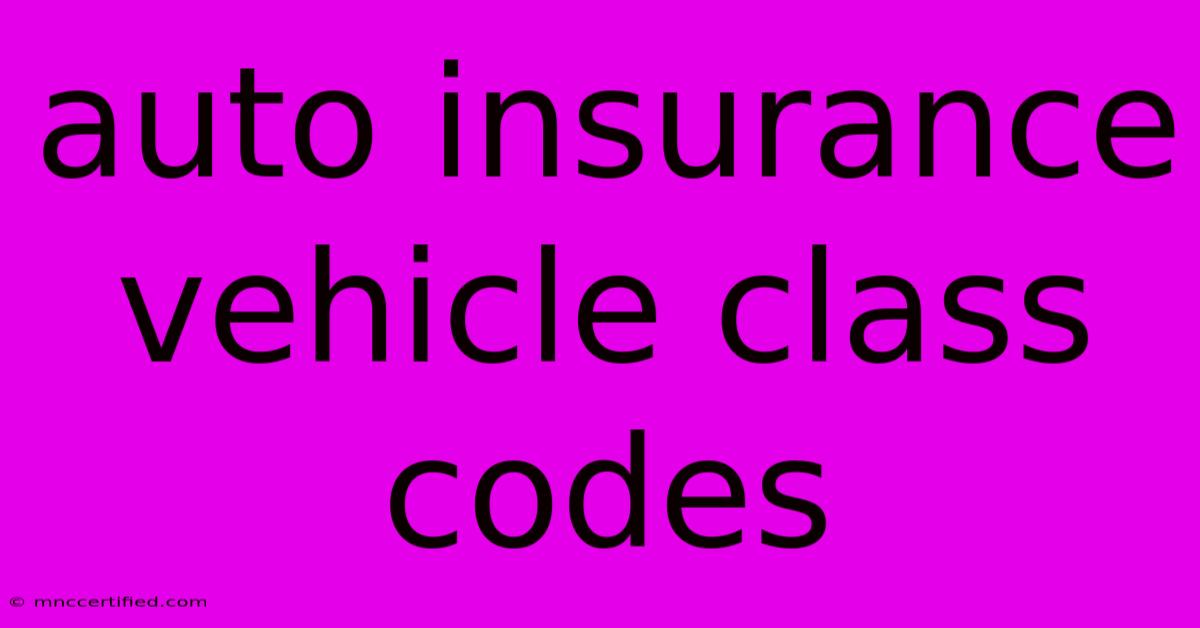Auto Insurance Vehicle Class Codes

Table of Contents
Decoding the Mystery: Understanding Auto Insurance Vehicle Class Codes
Choosing the right auto insurance can feel like navigating a maze. One of the key factors influencing your premium is something you might not even think about: your vehicle's class code. These seemingly arbitrary numbers actually hold significant weight in determining your insurance rate. This comprehensive guide will demystify auto insurance vehicle class codes, helping you understand how they affect your premiums and what you can do to potentially lower your costs.
What are Auto Insurance Vehicle Class Codes?
Auto insurance companies use vehicle class codes to categorize vehicles based on a variety of factors. These factors influence the risk associated with insuring that particular vehicle type. Think of it as a shorthand for a complex risk assessment. These codes aren't standardized across all insurance companies, meaning a code from one insurer might not directly translate to another. However, the underlying principles remain consistent: vehicles with higher risk profiles will generally fall into higher class codes, resulting in higher premiums.
Key Factors Determining Vehicle Class Codes:
- Vehicle Type: This is a major factor. A compact car will likely have a different class code than a large SUV, a sports car, or a pickup truck.
- Vehicle Size and Weight: Larger, heavier vehicles are often associated with higher repair costs and increased potential for damage in accidents, leading to higher class codes.
- Safety Features: Vehicles with advanced safety features, such as anti-lock brakes (ABS), electronic stability control (ESC), and airbags, might fall into lower class codes due to their reduced accident risk.
- Performance and Engine Size: High-performance vehicles with powerful engines tend to have higher class codes due to their increased risk of accidents and higher repair costs.
- Theft Risk: Some vehicle models are more prone to theft than others. This factor contributes to the assigned class code.
- Repair Costs: The cost of parts and labor for repairs is a significant factor. Vehicles with expensive parts and complex repair procedures will usually have higher class codes.
How Vehicle Class Codes Impact Your Premiums
Higher vehicle class codes generally translate to higher insurance premiums. This is because insurance companies perceive a greater risk associated with insuring these vehicles. The increased risk stems from factors like higher repair costs, increased likelihood of accidents, and greater potential for injury. Understanding your vehicle's class code is crucial to understanding your insurance rate.
Finding Your Vehicle's Class Code
Unfortunately, there isn't a central, publicly accessible database of vehicle class codes. The best way to find out your vehicle's class code is to contact your insurance provider directly. They will be able to provide this information based on your vehicle's year, make, and model.
Strategies to Lower Your Auto Insurance Premiums
While you can't change your vehicle's class code, you can explore strategies to potentially lower your overall premium:
- Shop Around: Compare quotes from multiple insurance providers. Different companies use different rating systems, and you might find a better rate with one company than another.
- Improve Your Driving Record: A clean driving record is a major factor in determining your premium. Avoiding accidents and traffic violations can significantly lower your rates.
- Bundle Your Insurance: Bundling your auto insurance with other types of insurance, such as homeowners or renters insurance, can often result in discounts.
- Increase Your Deductible: A higher deductible means you'll pay more out-of-pocket in the event of an accident, but it can lower your premium.
- Consider Safety Features: If you're planning to buy a new car, prioritize vehicles with advanced safety features. These features can impact your insurance class code positively.
Conclusion: Understanding is Key
Auto insurance vehicle class codes are a critical component of determining your insurance premium. While you can't directly control your vehicle's class code, understanding the factors that influence it empowers you to make informed decisions about your vehicle choice and insurance coverage. By understanding these codes and employing the strategies outlined above, you can work towards securing the best possible auto insurance rates. Remember to always compare quotes and contact your insurer for specific information regarding your vehicle's class code and its impact on your premium.

Thank you for visiting our website wich cover about Auto Insurance Vehicle Class Codes. We hope the information provided has been useful to you. Feel free to contact us if you have any questions or need further assistance. See you next time and dont miss to bookmark.
Featured Posts
-
Taylor Vs Serrano 2 Fight How To Watch
Nov 16, 2024
-
10 To 140 Nations League Accumulator
Nov 16, 2024
-
Auto Insurance Vehicle Class Codes
Nov 16, 2024
-
Swimming Pool Contractor Insurance
Nov 16, 2024
-
Heacock Insurance Lakeland Florida
Nov 16, 2024